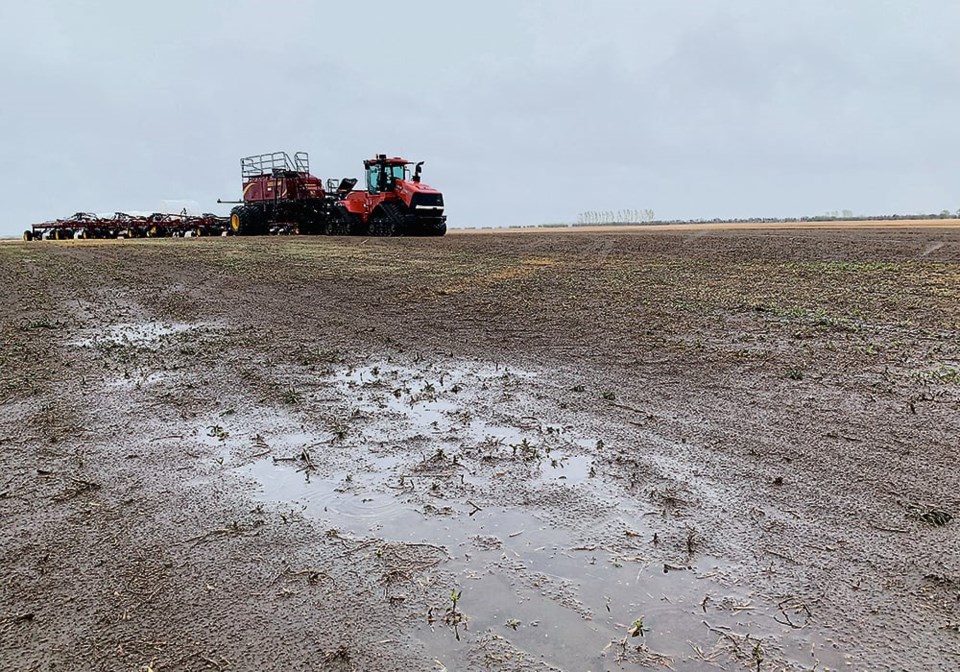WESTERN PRODUCER — Soil moisture conditions are improving across much of Canada and the United States cropping regions, thanks to recent rain, but the market last week was focused on excess rain in southern Brazil.
Canadian farmers on the Prairies are eager to get seeding, but they also appreciate the moisture from recent systems that is helping to make up for a dry winter.
The first Saskatchewan crop report comes out after this column was written so I don’t know how much has been seeded so far, but the five-year 2018-22 average is that 23 per cent is in the ground by the May 9-13 period, ranging from a low of nine per cent in 2018 and 2023 to a high of 38 per cent in 2021 and in 2019. I expect this year we’ll be on the low end of that range.
Farmers in the Dakotas and Montana also received moisture recently, but their seeding progress was already ahead of normal when the rain fell.
Any concerns about drought or dry conditions across the American corn belt have been put to rest by recent rain associated with storms that also sparked deadly tornadoes. Farmers there had also made good planting progress before the rainstorms, and so are not in a dangerously slow position.
However, more rain is expected this week in the western half of the Canadian Prairies and in much of the southern U.S. and the Midwest, and if it continues beyond that, worries about delayed seeding will start to mount.
The rain last week missed western Kansas, and the rain expected this week over much of North America’s agricultural regions will again avoid that hard red winter wheat region.
The weekly crop condition report issued April 28 showed that the amount of winter wheat in Kansas rated poor to very poor increased to 31 per cent from 26 per cent the previous week. Wheat in Nebraska and Oklahoma is doing better. The amount of the crop flowering and heading is well ahead of normal.
While rain was generally a good thing so far in North America, the deluge that southern Brazil got was not.
In Rio Grande do Sul, flooding killed at least 37 people. It delayed harvest of the final 25 per cent of the soybean crop and affected transportation infrastructure.
Harvest is also delayed in Argentina.
It’s the latest problem in that country. The Buenos Aires grains exchange last week lowered its corn crop estimate to 46.5 million tonnes, down from 49.5 million in its last forecast and down from the early season hopes for 56.5 million.
An infestation of leaf hoppers that spread corn stunt disease is causing havoc. Also, heat and dry weather in March took a toll.
The exchange kept its soybean forecast at 51 million tonnes, but said there was potential for reductions. Argentina’s grain exports are affected by labour disruptions at its ports.
The troubles in Â鶹ÊÓƵ America triggered a rally in Chicago soy and corn futures.
Corn and oilseed futures rose two to three per cent last week.
The market is also monitoring dry weather in southern Russia in the important winter wheat growing region between the Black Sea and Caspian Sea. It is also dry in eastern Ukraine.
The outlook for the region is for dry weather in the first half of May, and analyst SovEcon reported May 2 that it expects to cut its Russian production forecast in coming weeks.
Meanwhile, Russian consultancy IKAR on May 3 cut its forecast for the total winter and spring crop to 91 million tonnes from 93 million in March. IKAR pegged last year’s crop at 91.6 million tonnes.
In Europe, excess rain remains a problem in Britain, where the U.K. Flour Millers trade association said it expected the wheat crop to be 40 per cent lower than last year. The condition of the French soft wheat is at a four year low.
However, the European Union’s crop monitoring service, MARS, said in mid-April that warm temperatures in the spring had helped the continent’s crops generally. At the time, it raised its forecast for soft wheat to 5.93 tonnes per hectare from 5.91 tonnes in March.
Durum yields were raised to 3.47 tonnes from 3.44 in March.
Both estimates were a little higher than the five-year average. Seeded area is lower, however, so the total production could be smaller than last year.
In Australia, farmers are seeding winter wheat. Moisture is generally good in the eastern wheat region, but in the states of Â鶹ÊÓƵ Australia and Western Australia it is dry and moisture is needed for germination.
The U.S. Department of Agriculture’s attache in Australia has an early forecast of 25.8 million tonnes for the wheat crop, a little below the average and well below last year’s record bin busting 40.5 million tonnes.




